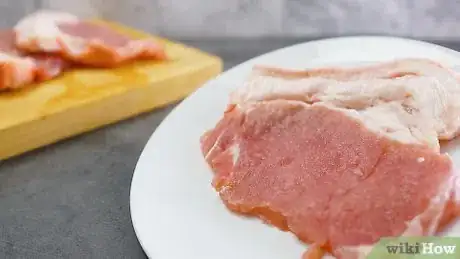This article was co-authored by wikiHow staff writer, Janice Tieperman. Janice is a professional and creative writer who has worked at wikiHow since 2019. With both a B.A. and M.A. in English from East Stroudsburg University, she has a passion for writing a wide variety of content for anyone and everyone. In her free time, you can find her working on a new crochet pattern, listening to true crime podcasts, or tackling a new creative writing project.
There are 8 references cited in this article, which can be found at the bottom of the page.
The wikiHow Culinary Team also followed the article's instructions and verified that they work.
This article has been viewed 29,198 times.
Learn more...
Chicken, beef, pork, and other cuts of meat can be a delicious part of your meal, but it can be disappointing when these meats turn out dry and tough. There’s no magic button on your oven that will keep your food from drying out, but there are a few easy precautions you can take that may help your meat taste juicy and flavorful after you take it out of the oven.
Ingredients
Milk-Based Cooking Sauce
- 2 1⁄2 c (590 mL) of milk
- 2 lemons, zested
- 1 cinnamon stick
- Sage leaves
- 3-4 garlic cloves
Steps
Choosing and Prepping Meat
-
1Select fattier cuts of meat for your recipes. Consult a butcher instead of buying your meat directly off the shelves and coolers. Ask if you can get cuts of meat with a little bit of fat attached, or with the bone still in. If you use a fattier selection of meat, your cut won’t be as likely to dry out in the oven.[1]
- For instance, chicken thighs will almost always turn out moist after being baked in the oven, as opposed to chicken breasts.
- As it cooks, the fat will melt into a liquid that keeps the meat moist.
-
2Pour a simple milk-based sauce over the meat before cooking it. Place your meat in a large baking tray, then pour in 2 1⁄2 c (590 mL) of milk. Add in 2 lemons worth of zest, along with 3-4 garlic cloves, a cinnamon stick, and a few sage leaves. Bake your meat for 1 hour and 30 minutes at 375 c (89,000 mL), and enjoy![2]
- This recipe works especially well with a whole chicken.
- Any milk-based sauce recipe will help keep your meat juicy while it cooks.
Advertisement -
3Soak your meat in a brine before popping it in the oven. Place your cut of meat on a baking dish, then sprinkle some salt and pepper over top. For juiciest meat, try soaking your meat in a homemade brine solution before cooking it. Submerge the meat in the brine and place it in the fridge for several hours so it can soak up the salty solution.[3]
- Brines work for a variety of meats, like turkey and pork chops.
-
4Bring refrigerated meat to room temperature before you cook it. Place your refrigerated cut of meat on a clean plate, then let it sit for about 15 minutes so it can adjust to room temperature. If you transfer your meat from the refrigerator to the oven, it won’t cook evenly and may end up dry.[4]
-
5Cover your meat with parchment paper or foil before cooking it. Place your section of meat on a baking tray, then rip away a section of foil and parchment paper. Drape the paper or foil over your meat, then stick it in the oven for the required time. As your meat cooks, the covering will help it retain more of its own juices.[5]
- This is also known as “dry-poaching.”
Ensuring Moist Results in the Oven
-
1Sear your meat on the stovetop before putting it in the oven, if desired. Grease a skillet and let it heat up on your stove. Place your cut of meat down with the fattiest side of meat touching the pan. Leave your cut of meat in place for 2-3 minutes, then flip it over. Check the internal temperature of the meat to see if it’s fully cooked or not—if the meat is still raw, place it in the oven for 10 minutes or so, using a thermometer periodically to see if the meat is fully cooked.[6]
- The exact cooking temperature will depend on the type of meat you’re working with. Double-check your recipe before you start cooking, just to be safe.
- For instance, seared pork chops need to bake at 400 °F (204 °C).
-
2Choose the best oven settings for your cut of meat. Think about the type of meat you’re planning on cooking, along with how thick or tender the cut is. Note that more tender sections of meat can be roasted and oven broiled, while thicker sections of meat are better prepared with moist heat, like a slow cooker.[7]
- Roasting is a great option if you’re working with a large section of meat.
- For example, baked chicken and pork chops need to be cooked at 400 °F (204 °C) in the oven, while a whole turkey needs to be baked at 350 °F (177 °C).[8]
-
3Test the meat with a thermometer to monitor the internal temperature. Stick a meat thermometer into the thickest part of your cut of meat before taking it out of the oven. Double-check that the meat reaches the recommended temperature but isn’t too far over. If it gets too hot, the meat will dry out.[9]
- You can always check the meat while it’s cooking to see how the internal temperature is looking.
- For an exact list of temperature recommendations, check here: https://www.cdc.gov/foodsafety/keep-food-safe.html.
-
4Let the meat sit for 5 minutes after taking it out of the oven. Take your meat out of the oven and transfer it to a clean plate. Don’t dig into your food right away—instead, set a timer for 5 minutes and allow the meat to “rest,” or become more tender and moist.[10]
- This may seem inconsequential, but these 5 minutes can make a big difference!
-
5Repurpose overcooked meat into savory pies and dumplings. Chop your meat into fine pieces, then mix it in a blender with cooking sherry and any leftover drippings. Use this purée as a filling for pasta, dumplings, or any other stuffed food of your choice![11]
- Unfortunately, there’s no way to restore your meat back to its original tenderness, but you can recycle it for something else!
Tip: You can repurpose overcooked beef by deep frying it and turning it into jerky.
Things You’ll Need
Selecting the Best Seasonings and Meats
- Salt
- Pepper
- Cooking pan
- Brine
Trying Specific Cooking Methods
- Skillet
- Cooking oil
- Plate
- Parchment paper
- Aluminum foil
- Meat thermometer
- Meat thermometer
- Cooking sherry
- Food processor
References
- ↑ https://www.thekitchn.com/5-important-tips-to-follow-to-prevent-dry-chicken-243269
- ↑ https://www.thekitchn.com/5-important-tips-to-follow-to-prevent-dry-chicken-243269
- ↑ https://www.thekitchn.com/5-mistakes-to-avoid-when-cooking-pork-chops-cooking-mistakes-218345
- ↑ https://www.thekitchn.com/5-mistakes-to-avoid-when-cooking-pork-chops-cooking-mistakes-218345
- ↑ https://www.thekitchn.com/5-important-tips-to-follow-to-prevent-dry-chicken-243269
- ↑ https://www.allrecipes.com/article/how-to-sear-meats/
- ↑ https://meatscience.org/TheMeatWeEat/topics/meat-safety/meat-cookery
- ↑ https://www.allrecipes.com/recipe/43655/perfect-turkey/?internalSource=hub%20recipe&referringContentType=Search
- ↑ https://www.thekitchn.com/5-important-tips-to-follow-to-prevent-dry-chicken-243269
- ↑ https://www.thekitchn.com/5-mistakes-to-avoid-when-cooking-pork-chops-cooking-mistakes-218345
- ↑ https://www.bonappetit.com/test-kitchen/how-to/article/overcooked-meat
- ↑ https://www.thekitchn.com/5-mistakes-to-avoid-when-cooking-pork-chops-cooking-mistakes-218345
- ↑ https://www.bonappetit.com/test-kitchen/common-mistakes/article/pork-chop-common-mistakes
- ↑ https://www.allrecipes.com/recipe/219173/simple-beef-pot-roast/























































